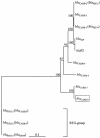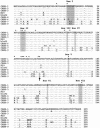CARB-9, a carbenicillinase encoded in the VCR region of Vibrio cholerae non-O1, non-O139 belongs to a family of cassette-encoded beta-lactamases
- PMID: 15388476
- PMCID: PMC521914
- DOI: 10.1128/AAC.48.10.4042-4046.2004
CARB-9, a carbenicillinase encoded in the VCR region of Vibrio cholerae non-O1, non-O139 belongs to a family of cassette-encoded beta-lactamases
Abstract
The gene bla(CARB-9) was located in the Vibrio cholerae super-integron, but in a different location relative to bla(CARB-7). CARB-9 (pI 5.2) conferred beta-lactam MICs four to eight times lower than those conferred by CARB-7, differing at Ambler's positions V97I, L124F, and T228K. Comparison of the genetic environments of all reported bla(CARB) genes indicated that the CARB enzymes constitute a family of cassette-encoded beta-lactamases.
Figures



References
-
- Chakraborty, S., P. Garg, T. Ramamurthy, M. Thungapathra, J. K. Gautam, C. Kumar, S. Maiti, S. Yamasaki, T. Shimada, Y. Takeda, A. Ghosh, and G. B. Nair. 2001. Comparison of antibiogram, virulence genes, ribotypes and DNA fingerprints of Vibrio cholerae of matching serogroups isolated from hospitalised diarrhoea cases and from the environment during 1997-1998 in Calcutta, India. J. Med. Microbiol. 50:879-888. - PubMed
MeSH terms
Substances
Associated data
- Actions
LinkOut - more resources
Full Text Sources
Research Materials
Miscellaneous

